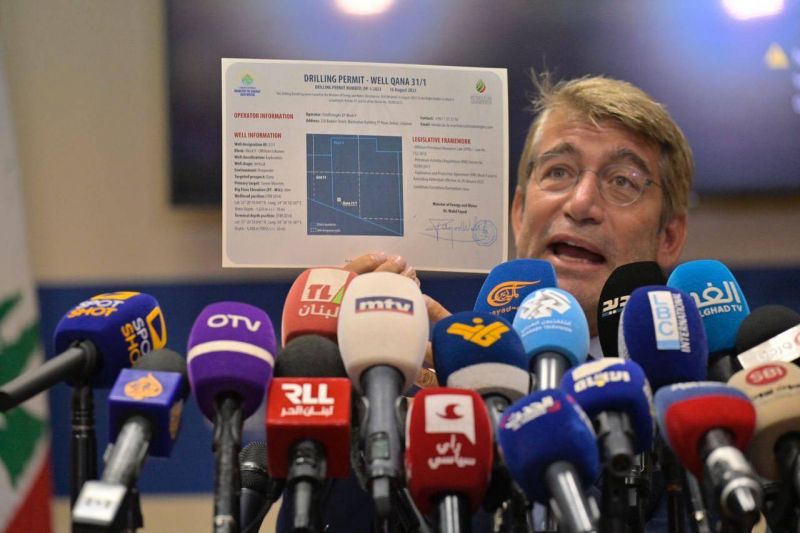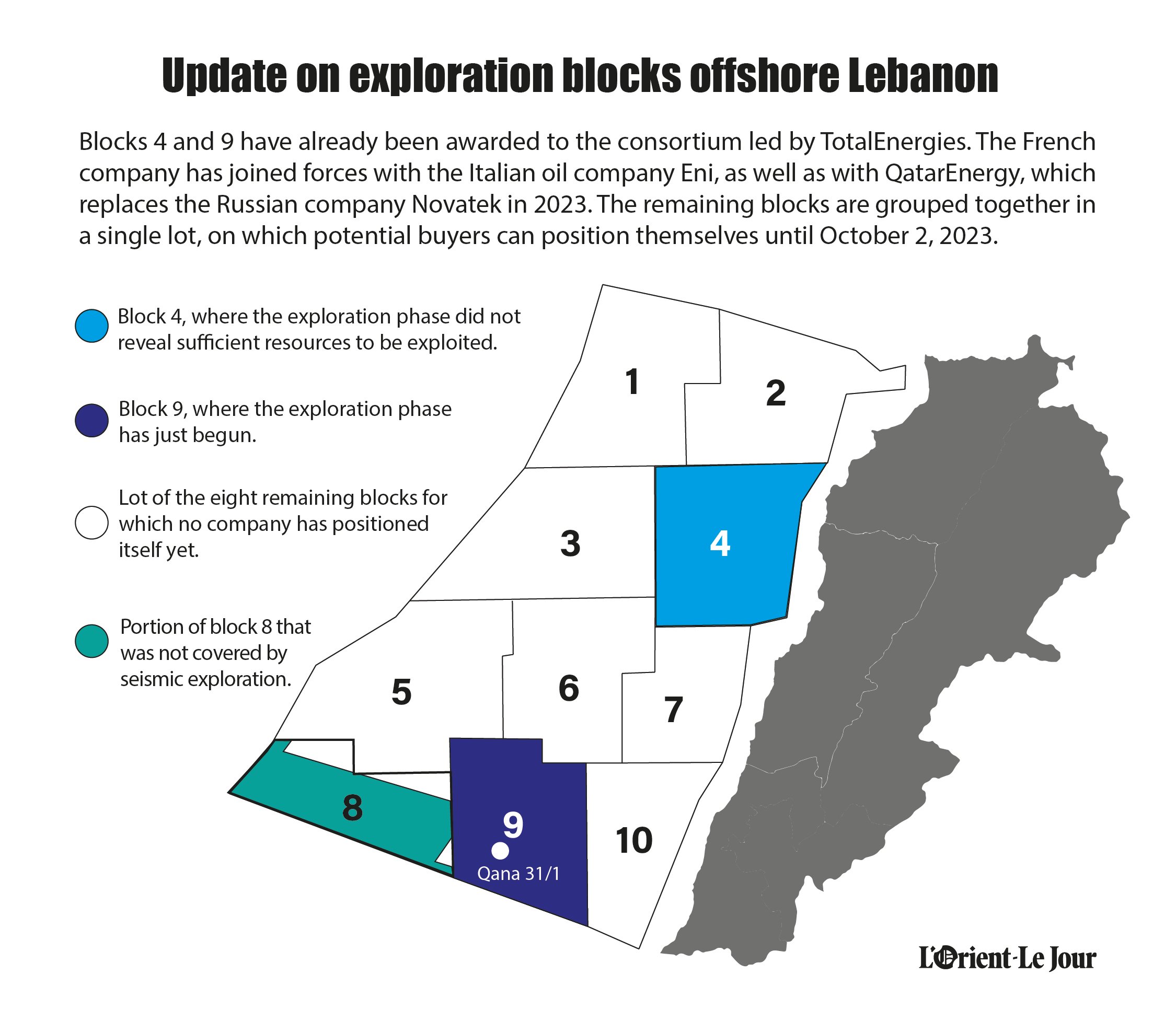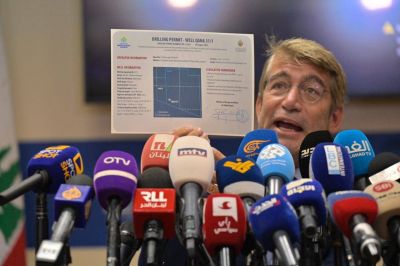
Lebanon's caretaker Minister of Energy, Walid Fayad, on August 24, 2023, during a press conference at the Ministry in Beirut. (Courtesy of Nabil Ismail)
BEIRUT — The caretaker Minister of Energy and Water, Walid Fayad, announced on Thursday during a press conference the launch of a three-dimensional (3D) seismic study of the seabed of block no.8 in the exclusive economic zone (EEZ) off the Lebanese coast, which is potentially rich in natural gas.
Fayad indicated that the license for the study was awarded to the companies Geoex MCG, based in the United Kingdom, and Brightskies Geoscience (BGS), established in Egypt, after a direct negotiation procedure was led by the Ministry. He added that the operation should enhance Lebanon's attractiveness to oil companies, to which he hopes to grant new exploration and exploitation licenses.
Meanwhile, drilling has begun in block No. 9, by the consortium composed of French company TotalEnergies, Italian company Eni, and QatarEnergy, which replaced the Russian company Novatek at the beginning of the year. The consortium acquired the first exploration and exploitation licenses granted by Lebanon for block No. 9 in 2018. The consortium hopes to discover sufficient gas reserves to start extraction.
Blocks no. 8 and no. 9 fall in an area disputed between Lebanon and Israel, whose maritime border problem was resolved with a historic agreement concluded on October 13, 2022. Since the agreement, the two countries have shared the Qana gas field.

What is the purpose of the 3D seismic study?
The 3D seismic study is a soil imaging technique that gives oil companies a better understanding of the hydrocarbon potential of studied areas, thus reducing the risk of drilling without discovery. Deploying a drilling platform is high in cost and requires significant investments. Companies conducting this type of study generally sell their results at high prices, to companies that are potentially interested in acquiring the right to explore a given area.
3D seismic imaging is typically conducted after a 2D study, which is akin to an initial ultrasound of the subsurface and uses a different technology. "The combined results of these two studies provide the highest level of visibility to oil companies that are exploring the composition of the subsurface and allow them to choose the most optimal drilling points. They also save them a lot of time, but do not reduce the risk of finding nothing to zero," explained Marc Ayoub, associate fellow at the Issam Fares Institute at the American University of Beirut, to L'Orient-Le Jour.
The granted license is limited to the execution of the surface study, as Wissam Chbat, chairman of the board of directors of the Energy Authority (the Lebanese Petroleum Association or LPA), explained to L'Orient. Walid Fayad reiterated during the press conference that the licenses granted are not exclusive and that nothing prevents other companies from applying to obtain their own licenses to conduct the same type of study in parallel with those that are ongoing.
How are the operations carried out?
Present at the Ministry were Geoex MCG Executive Vice President Jean-Philippe Rossi and BGS CEO Nizar Abou Ismail, who presented to journalists the major steps and challenges of the study, which will be launched by the end of the year and whose final results will be available by the end of the first half of 2024. The study will cover the 1,400 square kilometers of block No. 8, and the ship specially equipped for this type of operation—the PXGEO 2—is expected to arrive in Lebanon between mid-November and mid-December this year. The actual scanning duration will take about a month and a half, and the data will then be compiled to create the subsurface map.
The company itself is financing the study. The amount invested has not been disclosed, but it will be recouped by providing the collected data to interested oil companies, according to explanations given during the conference. The state will also receive a percentage of the profits from the data sold, said Fayad. This percentage was not disclosed by the speakers. "It is the company that bears the risk that the study may not be sold," Wissam Chbat clarified to L'Orient-Le Jour.
Why now?
While Lebanon initiated seismic studies of its EEZ in 2D and 3D in the 2000s—with Petroleum Geo-Services and PGS handling them—the scanning of most of block No. 8, which was largely located in the contested zone between Lebanon and Israel, had been postponed.
"In contrast, the 3D study of block No. 9 has already been completed, as only 10 percent of its area was included in the disputed zone, while a significant portion of block No. 8 could be affected," detailed Marc Ayoub. He added that the 2D seismic study was conducted on the entire latter block, as well as on the rest of the areas within the EEZ, referring to the maps published on the LPA's website.
Marc Ayoub said he is not surprised that the Ministry of Energy waited this long to complete the 3D study of block No. 8, despite the agreement with Israel having been signed several months ago. "The fact that Lebanon has very recent seismic data for block No. 8 will limit the risk of selling its exploration and exploitation rights at low prices and will strengthen the competition among interested parties," he believes.
Ayoub's analysis is echoed by Laury Haytayan, Middle East and North Africa Director at the Natural Resource Governance Institute (NRGI), an organization focused on improving governance in countries with natural resources. "Seismic studies are the main, if not the only, selling point of Lebanese authorities to attract oil companies. This was true before, when Lebanon began confirming the potential hydrocarbon reserves in its EEZ, and it remains true today," Haytayan stated.
She also recalled that the first exploration drilling conducted by the consortium in block No. 4 in 2020 did not result in the discovery of exploitable gas reserves and that the exploration process of block No. 9 was delayed due to the border dispute. The fact that Lebanon has been facing a multidimensional crisis since 2019 has also discouraged potentially interested companies.
"If positive, the results of the 3D seismic study of block No. 8 combined with those of the exploration drilling in block No. 9 could potentially change the situation and particularly stimulate the appetite of the consortium led by TotalEnergies," Haytayan said.
At the end of June, the LPA extended the current deadline for submission in the allocation process to October 2. On the other side of the border, Israel is already in its fourth round of license allocation and has already started exploiting some gas fields.
Haytayan points out another important factor that could impact the attractiveness of the southern part of the Lebanese EEZ in the coming months: the fact that block 72 in the Israeli EEZ, which is adjacent to the border, has not yet been allocated. "It was included in the third round, but the process was suspended due to the disqualification of one of the two candidates, Chevron from the US, opposed to Energean based in London. It has not been put back into play even after the October agreement between Lebanon and Israel," she concluded.
This article was originally published in French in L'Orient-Le Jour.

